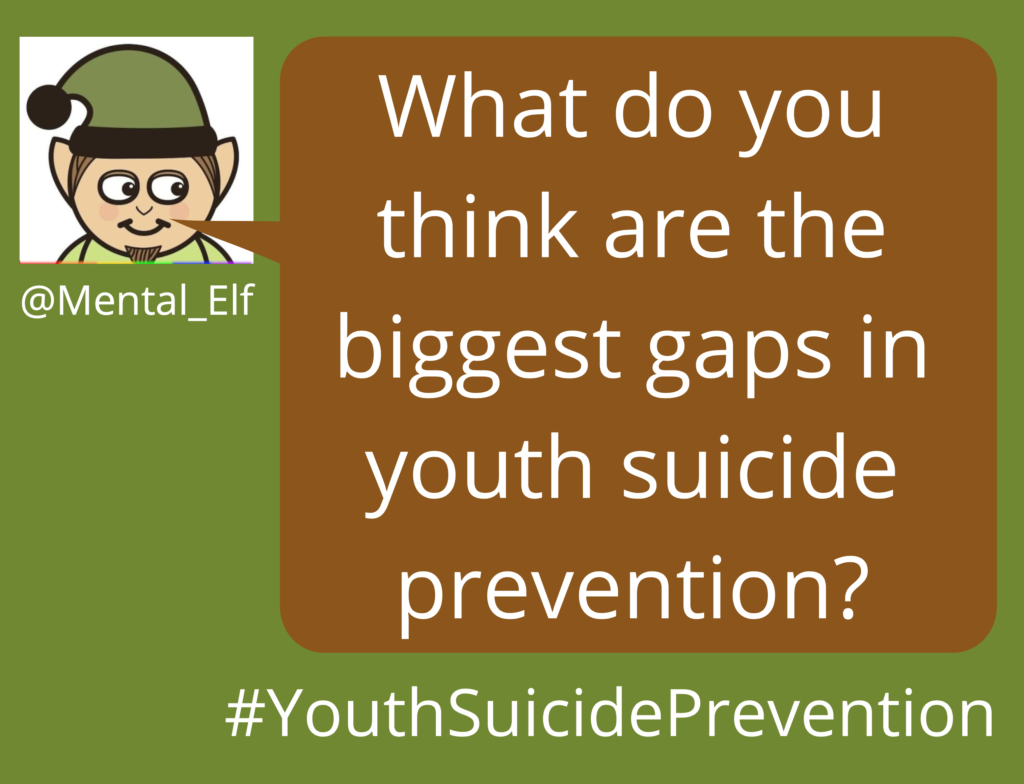
An abundance of research now exists to suggest that young people are at increased risk of suicide and self-harm, while rates are continually increasing (Campisi et al., 2020; Kothgassner et al., 2020; Klonsky et al., 2104; McLoughlin, Gould & Malone, 2015). Despite this, research shows that there has been limited progress in reducing suicide rates in this group for almost 60 years (Iyengar et al., 2018; Ougrin et al., 2015).
A previous systematic review concluded that the field of youth suicide prevention research needs a shake-up (Robinson et al., 2018). This study looked at universal (those targeting a whole population), selective (those targeting at-risk youth) and indicative (those targeting individuals who have already shown signs of suicidal behaviour) interventions. Out of these three approaches to intervention, by far the most frequently studied was indicative, with 66 out of 99 studies focussing on these.
One type of indicative intervention that is often used in the treatment of suicide and self-harm are psychotherapies. For instance, NICE guidelines currently state that treatment for suicide and self-harm should include psychological therapies. Whilst there has been some evidence to date suggesting that such therapies may help to reduce suicide and self-harm in young people, these have tended to compare only one individual treatment with a comparison group, and it is, therefore, not possible to conclude which treatments may be the most beneficial to this group.
The current network meta-analysis by Bhaji and colleagues (2021) aimed to examine the comparative efficacy and safety of psychotherapies for the treatment of self-harm and suicidal behaviours among children and adolescents.

Despite increasing rates of self-harm and suicide in children and young people, there has been limited progress in reducing suicide rates in the past 60 years.
Methods
Four databases were searched. Randomised controlled trials (RCTs) measuring self-harm or suicidal behaviour among children or adolescents aged 10-19 years were eligible for inclusion. Self-harm was defined as any intentional injury to oneself, regardless of suicidal motivation. Studies were excluded if they used non-randomised designs, crossover RCTS or had missing or unobtainable data.
Interventions were categorised into the following groups:
- Brief intervention (including brief motivational interviewing sessions, hospital admission tokens, brief app-based interventions, youth-nominated support teams)
- Cognitive analytic therapy (CAT)
- Cognitive behavioural therapy (CBT)
- Dialectical behavioural therapy (DBT) (including emotion regulation training and mindfulness interventions)
- Family-based therapy
- Interpersonal therapy
- Mentalisation-based therapy (MBT)
- Mode deactivation therapy
- Supportive therapy (including non-directive, non-specific interventions)
- Short-term psychoanalytic psychotherapy
- Eclectic therapies (clinical trials blending 3 or more modalities)
All included studies were assessed using the Cochrane risk of bias tool (Higgins et al., 2011). Risk of bias was also assessed across studies by graphing funnel plots, applying Egger tests and using Grading of Recommendations Assessment, Development and Evaluation (GRADE) guidelines (Guyatt et al., 2008).
The authors used Cohen’s d standardised mean difference and odds ratios to summarise effect sizes for continuous and dichotomous variables. Forest plots were graphed for each outcome measure and treatment rankings were created to represent each therapy’s effect size compared with treatment as usual.
Results
44 RCTs from 49 articles were included. Of those, 33 offered individual psychotherapy (as opposed to group) and the most common interventions were brief intervention, family-based therapy and dialectical behavioural therapy (DBT).
A high overall risk of bias was present in all 44 RCTs, and there was a high level of heterogeneity, so it’s not currently possible to reliably compare the efficacy and acceptability of psychotherapies for the treatment of self-harm and suicidal behaviours in children and adolescents.
| Outcome | End of treatment | Extended follow-up |
| Self-harm frequency | Eclectic therapy and dialectical behavioural therapy (DBT) associated with reductions in self-harm | Mentalisation-based therapy (MBT) and brief intervention plus treatment as usual associated with reductions in self-harm |
| Study withdrawals | None of the psychotherapies was associated with more study withdrawals compared with treatment as usual | |
| Suicide ideation | DBT and family-based therapy associated with reductions in suicide ideation | MBT and family-based therapy associated with reductions in suicide ideation |
| Depression severity | Family-based therapy associated with reduced depression symptom severity | No investigated psychotherapy associated with improvements in depressive symptoms |

Dialectical behavioural therapy reduced both self-harm and suicide ideation at end of treatment, but this was not maintained at follow-up. At follow-up, mentalisation-based therapy reduced both self-harm and suicide ideation.
Conclusions
Whilst the results of this network meta-analysis suggest that some psychotherapies are well tolerated and have efficacy for specific measures of self-harm or suicidality, the authors conclude that:
A lack of consistent evidence precludes a definitive hierarchy of treatments.
Strengths and limitations
The authors should be commended for this valuable contribution to the field of youth suicide prevention. The conducting of a network meta-analysis that compares treatments to one another as opposed to only evaluating one treatment at a time is a timely and well-needed contribution to this field.
Nonetheless, the study is not without limitations. The authors only included studies with populations aged between 10 and 19 years old. I would have liked to see a little further justification for why this age group specifically was chosen.
Although not a direct limitation of the study itself, by far the biggest barrier to being able to draw meaningful conclusions from this review was due to the low quality of evidence available which was subject to allegiance bias, selective reporting and incomplete outcome reporting biases. It is sad to see yet another systematic review conclude that the evidence base is not good enough to be able to draw solid conclusions. It begs the question, why are we spending so much public money on second-rate research into youth suicide prevention which ultimately isn’t reducing suicide in young people? This brings me to my point below…

“It is sad to see yet another systematic review conclude that the evidence base is not good enough to be able to draw solid conclusions.”
Implications for practice
The authors of this study suggest a need for further high-quality research, which explores the effectiveness of treatments for suicide prevention in young people.
So, I think it’s time we need to do something about this.
I’m therefore asking YOU to help me to define the future of youth suicide prevention research:
- What youth suicide prevention questions should we be prioritising?
- Should our research target specific groups of youths?
- What research methodologies should we be using to answer our questions?
I will be hosting a tweet chat on the @Mental_Elf account on Monday 24th May, 9am BST. We will be sharing evidence about what we already know about suicide prevention in young people and asking you to help us define future research in this area. Come along and have your say on the future of youth suicide prevention research. We’ll be using the hashtag #YouthSuicidePrevention.

Join us on Twitter at 9am BST on Monday 24th May to discuss the future of #YouthSuicidePrevention.
Statement of interests
Laura Hemming works for The Mental Elf as a project co-ordinator and is a researcher in the field of suicide prevention. The responses to the #YouthSuicidePrevention tweet chat will help Laura to shape a future piece of work in youth suicide prevention.
Links
Primary paper
Bahji, A., Pierce, M., Wong, J., Roberge, J. N., Ortega, I., & Patten, S. (2021). Comparative efficacy and acceptability of psychotherapies for self-harm and suicidal behavior among children and adolescents: a systematic review and network meta-analysis. JAMA network open, 4(4), e216614-e216614.
Other references
Campisi, S. C., Carducci, B., Akseer, N., Zasowski, C., Szatmari, P., & Bhutta, Z. A. (2020). Suicidal behaviours among adolescents from 90 countries: a pooled analysis of the global school-based student health survey. BMC public health, 20(1), 1-11.
Guyatt, G. H., Oxman, A. D., Vist, G. E., Kunz, R., Falck-Ytter, Y., Alonso-Coello, P., & Schünemann, H. J. (2008). GRADE: an emerging consensus on rating quality of evidence and strength of recommendations. Bmj, 336(7650), 924-926.
Higgins, J. P., Altman, D. G., Gøtzsche, P. C., Jüni, P., Moher, D., Oxman, A. D., … & Sterne, J. A. (2011). Cochrane bias methods group; cochrane statistical methods group. The Cochrane Collaboration’s tool for assessing risk of bias in randomised trials. BMJ, 343(7829), d5928.
Iyengar, U., Snowden, N., Asarnow, J. R., Moran, P., Tranah, T., & Ougrin, D. (2018). A further look at therapeutic interventions for suicide attempts and self-harm in adolescents: an updated systematic review of randomized controlled trials. Frontiers in psychiatry, 9, 583.
Klonsky, E. D., Victor, S. E., & Saffer, B. Y. (2014). Nonsuicidal self-injury: What we know, and what we need to know. The Canadian Journal of Psychiatry, 59(11), 565-568.
Knightsmith, P. Youth suicide prevention research needs a shake up: lives depend on it. The Mental Elf, 17th December, 2018.
Kothgassner, O. D., Robinson, K., Goreis, A., Ougrin, D., & Plener, P. L. (2020). Does treatment method matter? A meta-analysis of the past 20 years of research on therapeutic interventions for self-harm and suicidal ideation in adolescents. Borderline personality disorder and emotion dysregulation, 7, 1-16.
McLoughlin, A. B., Gould, M. S., & Malone, K. M. (2015). Global trends in teenage suicide: 2003–2014. QJM: An International Journal of Medicine, 108(10), 765-780.
Ougrin, D., Tranah, T., Stahl, D., Moran, P., & Asarnow, J. R. (2015). Therapeutic interventions for suicide attempts and self-harm in adolescents: systematic review and meta-analysis. Journal of the American Academy of Child & Adolescent Psychiatry, 54(2), 97-107.
Robinson J, Bailey E, Witt K, Stefanac N, Milner A, Currier D, Pirkis J, Condron P, Hetrick S. (2018) What Works in Youth Suicide Prevention? A Systematic Review and Meta-Analysis (PDF). EClinicalMedicine Vol 4, p 52-91, Oct 01, 2018 https://doi.org/10.1016/j.eclinm.2018.10.004
Photo credits
- Photo by Elevate on Unsplash
- Photo by Denys Argyriou on Unsplash
- Photo by Jen Theodore on Unsplash
- Photo by Ben White on Unsplash

“The responses to the #YouthSuicidePrevention tweet chat will help Laura to shape a future piece of work in youth suicide prevention.”
Very interesting blog and proposed tweetchat but I’m a little concerned by the invitation for young people with ‘lived experience’ to take part in the tweet chat. Lived experience of wanting to die, planning/attempting suicide, self-harm are huge issues for young people to deal with, and the research outcomes outlined here seem pretty bleak. Thinking through next steps could be quite a burden in this context. What arrangements for support and safeguarding are you putting in place to look after their interests when taking part in the very public chat?If the purpose of the chat is to develop future work in this area then ethical responsibilities should be covered by Laura’s university ethics code and hopefully you’ll have this in hand by Monday?